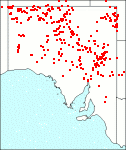Family: Poaceae
Enneapogon polyphyllus
Citation:
N. Burb., Proc. Linn. Soc., Lond. 153:69 (1941).
Synonymy: Pappophorum nigricans R. Br. var. polyphyllum Domin, Biblthca Bot. 85:381 (1915); P. nigricans R. Br. var. pallidum sensu Domin, Biblthca Bot. 85:381 (1915), non (R. Br.) Domin.
Common name: Leafy nineawn, limestone bottle-washers.
Description:
Annual or short-lived perennial c. 30 (rarely 3-48) cm, hispid with glandular hairs and pilose with simple hairs on the culms, leaves and panicle; culms sparsely branched: blades tightly convolute or involute, firmly acute: panicle 7-9 x 1-1.5 (rarely 1.5-11.7 x c. 2) cm (including the awns), spike-like, continuous, linear or lanceolate to elliptic.
Axillary inflorescences and spikelets absent: spikelet usually 5-6-flowered with 1 floret fertile; second and third florets on rhachilla-internodes 0.6-1.2 mm long; third, fourth and fifth florets crowded, the fourth reflexed or horizontal; glumes membranous, with broad thinner nerveless margins, lanceolate to ovate or elliptic, acute to acuminate, entire or minutely erose, muticous or mucronulate; lower 5-6 (rarely 4.2-8.2) mm long, 8-11- (rarely 5-13-) nerved; upper 5-6 (rarely 4.3-6.2) mm long, 5-8- (rarely to 11-) nerved; lowest floret: body 2-2.3 (rarely to 4.2)mm long, cartilaginous to hardened, smooth with faint or no nerves, bearded with hairs as long as the body itself or slightly longer, with membranous wings on the margins, the wings sparsely ciliate in the upper part and glabrous below; awns 5-7 (rarely 3-11.6) mm long; the 2 peripheral awns with winged ciliate margins like the body of the lemma and wider at the base than the inner awns, sometimes with 2 nerves entering at the base; palea of lowest floret: body glabrous in the upper half to a third and hairy below; flaps partly hairy to almost glabrous; keels scaberulous in the upper half to two-thirds, characteristically winged and upturned; grain 1-2 x 0.8-1.5 mm, obovoid to ellipsoid; second floret: lemma glabrous, smooth; palea hairy; rhachilla glabrous.
Published illustration:
Lazarides (1970) The grasses of Central Australia, pl. 33c: Cunningham et al. (1982) Plants of western New South Wales, p. 96.
|
|
Distribution:
|
S.Aust.: NW, LE, NU, GT, FR, EA, EP, MU. All mainland States except Vic.
|
Conservation status:
native
Flowering time: throughout the year.
|

SA Distribution Map based
on current data relating to
specimens held in the
State Herbarium of South Australia
|
Biology:
A valued grazing species which regenerates at any time of the year after rain.
Author:
Not yet available
|

